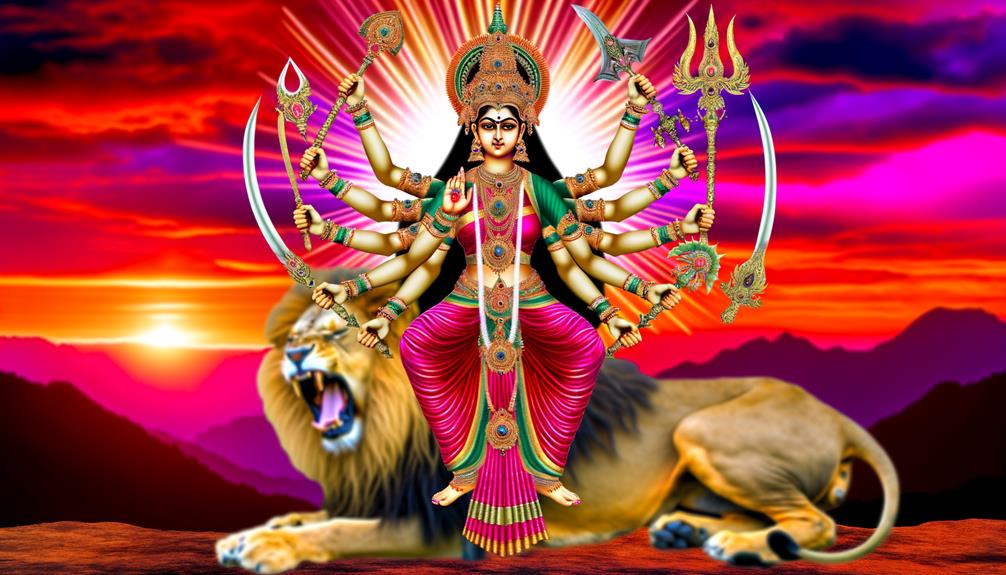Have you ever heard about Durga, the highly respected Hindu goddess, who's regarded as a beacon of power and safeguard in not just Hinduism, but Buddhism and other faiths as well?
Hindu tales portray her as a fearsome fighter, a caring mother, and the vanquisher of wickedness, personifying the ultimate form of divine female might.
The multifaceted nature of Durga's persona and her embodiment of resilience have always fascinated me. Consider this: What does it imply when a woman is both a caretaker and a fighter? How does this seemingly contradictory depiction shape her followers' perception of bravery and power?
As we delve into understanding Durga's resilience, we'll unravel the complexity of her personality and maybe get a renewed viewpoint on the timeless conflict of good versus evil.
So, are you ready to delve in?
Origin and Evolution of Durga

The story of Durga, the warrior Goddess from Hindu mythology, is an intriguing tale that intertwines with the socio-cultural evolution of ancient Indian society. Durga symbolises strength, protection and the victory of righteousness over wickedness.
The tale of Durga has many versions, but one of the most popular ones involves the buffalo demon, Mahishasura. This demon was invincible against any man or god, thanks to a boon he'd received. Using this to his advantage, Mahishasura caused widespread destruction, leaving the gods in a state of despair.
It was at this point that Durga came into the picture. The goddess was born from the combined energies of all gods, with Lord Shiva taking the lead. Each god gifted her a weapon, symbolising their individual powers.
Durga is considered an incarnation of divine female power, also known as Shakti. It was she, a woman, who achieved something that the male gods couldn't – the defeat of Mahishasura. This narrative not only secures Durga's place as a warrior Goddess, but it also suggests a shift towards matriarchy in ancient India.
Thus, the tale of Durga's origins and evolution isn't just a mythological account; it reflects the changing cultural dynamics of the time.
Iconography and Symbols of Strength
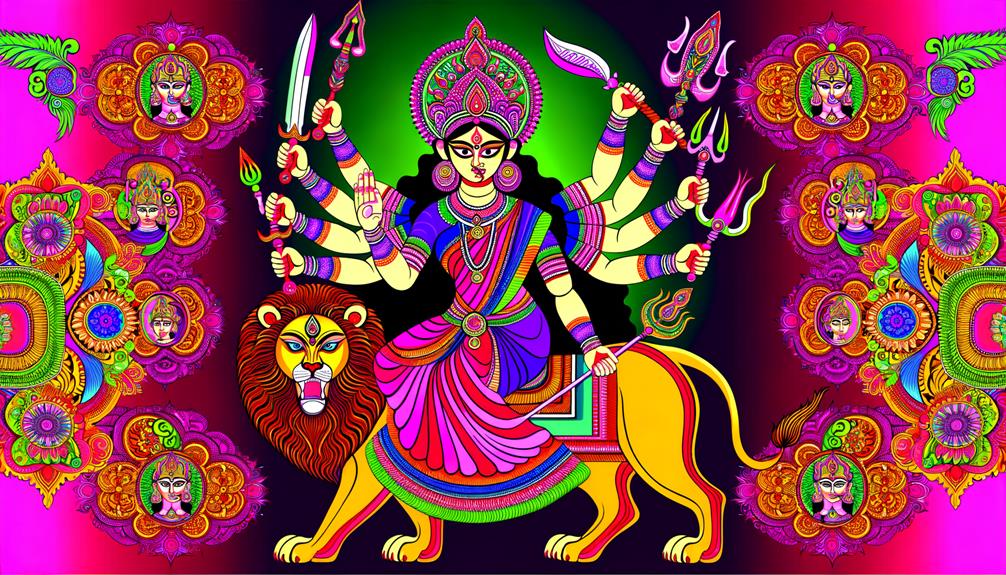
Let's dive into the fascinating world of iconography and symbols related to Goddess Durga. She's not just a deity; she's a symbol of strength and empowerment. Renowned in Hindu culture, Durga is honoured during a ten-day festival known as Durga Puja.
Picture her as a striking, potent figure, seated on a tiger, symbolising bravery and power. The tiger isn't just an animal; it's her residence, indicating her dominance.
Then, there are her ten hands, each holding a unique weapon. These aren't just ordinary weapons; they're gifts from various gods, each one representing their collective energy. The most significant symbol? That's her victory over the buffalo demon, Mahishasura. It isn't just a win; it represents the triumph of good over evil. It reinforces her role as a divine mother and a protector.
Let's simplify this with a quick table, showing the major symbols related to Durga and their meanings:
| Symbol | Meaning |
|---|---|
| Tiger | Strength, Bravery |
| Sudarshana Chakra | Virtue |
| Talvar | Intellect |
| Gad | Knowledge |
| Abhaya Mudra | Empowerment and Protection |
The depiction of Durga, through her iconography, is a source of strength and empowerment. Whether it's the lively celebrations of Durga Puja or the tranquil portrayals of the divine mother, the image of Durga serves as a constant reminder of courage and empowerment.
Durga's Significant Legends
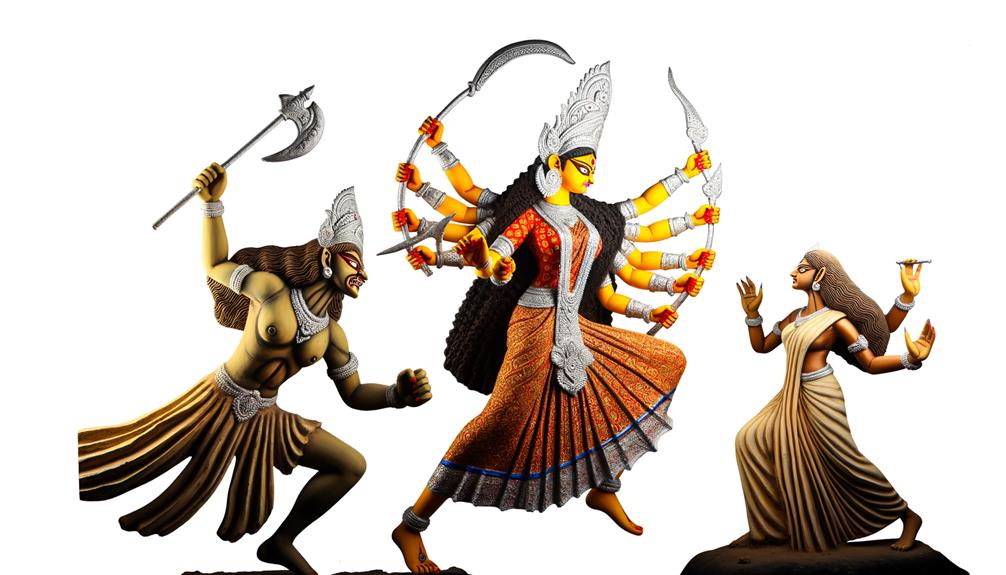
Let's dive into the captivating tales about Goddess Durga, with a special focus on her monumental clash with the demon Mahishasura. The stories about Durga are packed with meaning and important lessons. They also bring to light her power as the leading Goddess in Hindu mythology.
As per the Hindu scripture, Markandeya Purana:
- The fight between Durga and Mahishasura symbolizes the victory of righteousness over wickedness. This intense fight, which went on for nine days, mirrors our ongoing battle against negative forces. The climax of this fight sees Durga rise as 'Mahishasura Mardini', the destroyer of Mahishasura.
- The yearly festival of Navaratri commemorates Durga's win over Mahishasura. This occasion, filled with lively celebrations, is a renewal of our belief in the power of righteousness.
- During this time, believers read the Durga Saptashati, a holy text, to call upon the strength of Durga, the warrior goddess, to help us tackle life's hurdles.
These tales help us see Durga not just as a warrior Goddess, but also as a mother who symbolizes safety and kindness. Studying these stories deepens our knowledge and respect for Durga's place in Hindu mythology.
Worship and Celebrations of Durga
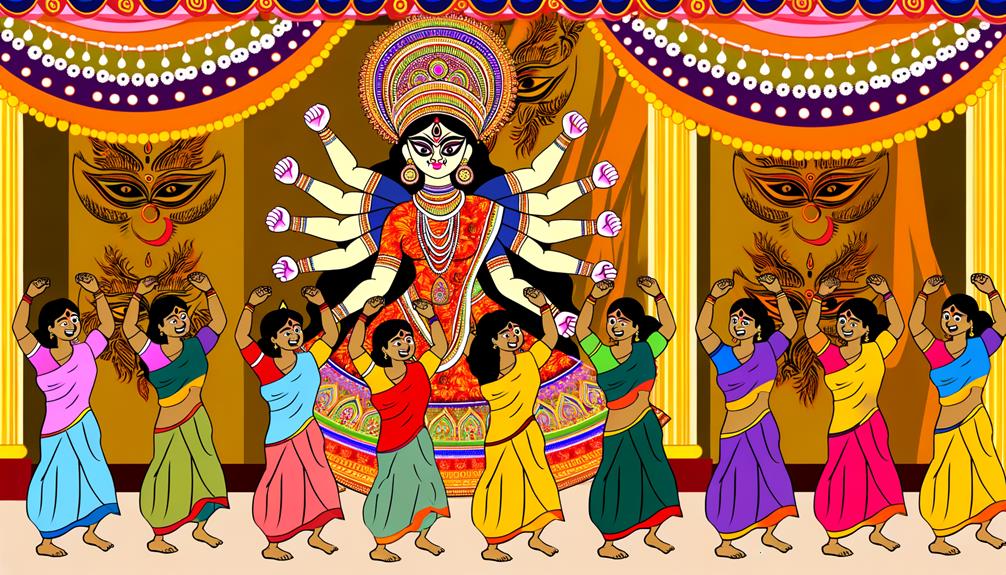
When we talk about Durga, we're referring to a revered warrior goddess who's known for her protective nature. Her celebrations are filled with intense prayers, vibrant festivities, and a whole lot of love. These celebrations peak during the festival of Navaratri and end with the joy-filled Dasera. Held over nine days, this Hindu festival is normally observed in September or October and takes on different forms all over India.
The people who worship Durga see her as a beautiful woman and a cherished mother. They show their love and respect by making offerings to her and asking for her protection. The way Durga is seen and worshipped is deeply connected to the Hindu scriptures, especially the Devi Mahatmya. Here, she's seen as a powerful warrior who received her weapons from other gods. When people are going through tough times, they read the Devi Mahatmya as a way to feel closer to Durga and draw strength from her.
During the Durga Puja festival, Durga statues are made and celebrated. These statues are then immersed in water, showing the cyclical process of creation and end. In essence, the way Durga is worshipped and celebrated shows her important role in Hindu mythology as a symbol of strength, protection, and motherly love. It's a way for people to feel a strong connection between themselves and the divine.
Durga's Influence Beyond Hinduism
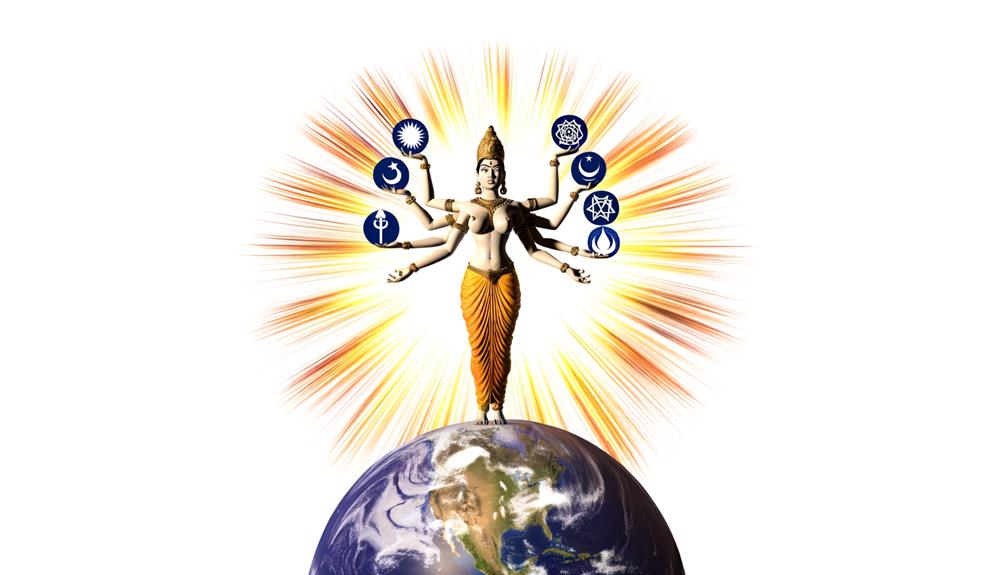
The significance of Durga isn't just limited to the Hindu faith – her presence is felt across various cultures and religions. The boundless strength of this warrior goddess is a theme that resonates universally. It's clear that Durga's impact stretches further than just Hinduism.
- Durga is revered in Buddhism, Jainism, and Sikhism and her divine feminine power is felt deeply across these faiths.
- Buddhists worship a version of Durga known as Palden Lhamo.
- For Jains, she's viewed as a deity who offers protection.
- In Sikhism, mentions of Durga can be found in the Guru Granth Sahib.
- Durga's attributes have fueled conversations about gender equality all over the world.
- Durga's representation as an emblem of feminine strength is powerful.
- Her inner strength is an enduring symbol of empowerment.
- Durga is honored in artwork and festivals, fostering unity and cultural pride.
- The way she's portrayed in art goes beyond religious borders.
- Festivals like Durga Puja honor her qualities of strength and compassion.
Frequently Asked Questions
What Is the Strength of Durga?
If you ask me, I'd say that Durga's real power is her commitment to justice, her fight against evil, and her ability to inspire courage. She embodies the most formidable force in the universe, showing not just tenacity and resolve, but also a deep, compassionate concern for people.
How Powerful Is Maa Durga?
My take on Maa Durga's power is that it's beyond our comprehension. She's the embodiment of the greatest cosmic energy, able to conquer evil with her unmatched strength and insight. The story of her victory over Mahishasura is a symbol of overcoming darkness, marking her as a figure of bravery and resolve.
What Are the Powers of the Goddess Durga?
You might be wondering, who is the goddess Durga and what are her powers? Well, let me tell you. Durga symbolizes the ultimate power, inner resilience, and unyielding will. She is known for her abilities to conquer the vices of greed and arrogance, all the while promoting justice and integrity. She is most celebrated for her victorious conquest over the demon Mahishasura, which is an allegory for overcoming negative forces.
Which Goddess Is Worshiped for Strength?
So, you're curious about which Goddess is revered for strength in Hinduism? You're in the right place! There are quite a few who are associated with strength, but let's chat about Goddess Durga. She's a big deal because she's the one who's specifically honored for her strength. Picture a figure of supreme power and courage, fearlessly taking on the forces of evil and standing up for virtue. That's Goddess Durga for you, embodying strength with her divine might. Quite impressive, isn't she?
Conclusion
Let's wrap this up by saying that the strength of Durga isn't just a legend. It's like a guiding light that stands as a living proof of the might of being just and righteous.
You know what they say, 'the pen is mightier than the sword.' The stories about her emphasize the significance of mental fortitude and ethical bravery.
The reach of Durga's character goes beyond the realm of faith, touching each part of our lives. We all can learn from her fierce strength and tenacity, validating the fact that the power of goodness will always defeat the evil.

